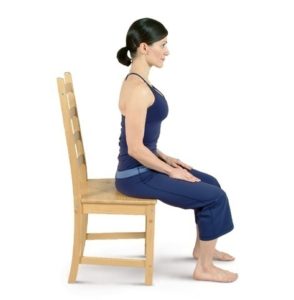Yoga as Therapy: Simple Steps to Find Balance
 Over the course of the last few years, yoga has become a very hot topic in western culture. People from all different athletic backgrounds try out yoga for the physical benefits of the practice, often looking to be challenged physically and mentally as a way to get into their bodies and into the present. However, not all yoga needs to result in sweat. Approaching yoga from a therapeutic perspective offers benefits for those who are looking to restore balance in the mind-body connection. This approach is inclusive and available for people of all fitness levels. The goal here is not to burn calories and gain physical strength, but instead to move energy out of stuck places, come back to the present, and empower individuals. Below are two general ways that yoga as therapy can help restore balance.
Over the course of the last few years, yoga has become a very hot topic in western culture. People from all different athletic backgrounds try out yoga for the physical benefits of the practice, often looking to be challenged physically and mentally as a way to get into their bodies and into the present. However, not all yoga needs to result in sweat. Approaching yoga from a therapeutic perspective offers benefits for those who are looking to restore balance in the mind-body connection. This approach is inclusive and available for people of all fitness levels. The goal here is not to burn calories and gain physical strength, but instead to move energy out of stuck places, come back to the present, and empower individuals. Below are two general ways that yoga as therapy can help restore balance.
Grounding. During times when we are feeling anxious and overwhelmed, we tend to live in our minds and pay no attention to our bodies. It can be helpful to use therapeutic yoga techniques to find a sense of groundedness when we find ourselves living in our minds instead of our bodies. The first step is to bring awareness to what is happening in the moment: what am I feeling? Am I ruminating or obsessing? Am I tense and shaking? Am I hyperfocused on the future? Is my breathing shallow and short? Once there is awareness, we can make steps to find balance in our minds and bodies.
Try these simple poses. All you need is a chair.
-Sit upright in your chair, so your feet are firmly grounded. Find length in the spine.
-Notice the breath. Begin matching the length of your inhale with the length of your exhale. For example: breathing in for 4, breathing out for 4.
-Matching breath with movement, begin shrugging the shoulders forward, up, back, and down. Do this for 5 breaths, and then switch directions moving back, up, forward, and down for 5 breaths.
-Come back to your seated upright position, and fold forward over your thighs. The goal here is not to touch the floor; only fold as much as you want to.
-Slowly make your way back to seated and scan the body, noticing any energy shifts that may have taken place.
Uplifting. Whether it is a gloomy day outside or you are living with some chronic depression, yoga as therapy can help bring a sense of fluidity, openness, and lightness on days when we are feeling particularly lethargic. Bringing life back into the body through therapeutic yoga techniques can help combat the avoidance, heaviness, and numbness that comes along with depression or depression-like symptoms. Just as with the grounding exercises, it begins by bringing awareness to the qualities of the moment: what am I feeling? Even identifying one quality can be helpful in making steps towards balance.
Try these. Once again, all you need is a chair.
-Sit upright in your chair, maybe on the edge of your chair and root down with your feet on the ground. Notice how it feels to hold your own body upright without the back of the chair as a support.
-Notice the breath in any way that you can. Simply bring awareness.
-On an inhale, lean forward slightly, leading with the chest. On an exhale, lean back slightly and curl the spine. Continue, moving with your breath for 5 breaths.
-Bring your hands in front of your chest and hook your thumbs together, making an “eagle” or bird shape with your hands. On an inhale, bring the hands overhead. On an exhale, unhook the thumbs and extend the arms out to the sides as they come back down to your lap. Repeat this for 5 breaths.
-Return to your seated upright position. Sweep the arms overhead. Inch the hips closer to the edge of the chair and start shifting your weight into your feet, keeping your arms and torso uplifted. Maybe you stay here, and feel the sense of empowerment and inner strength being cultivated. Maybe you continue to shift the weight and find yourself completely off the chair, standing on your own two feet.
If you were able to try out any of these steps, hopefully you found a sense of groundedness or upliftment. These examples are just small tastes of what yoga as therapy can offer when done regularly or with a yoga therapist.
Posted by Katie McCarthy
Boston Post Adoption Resources